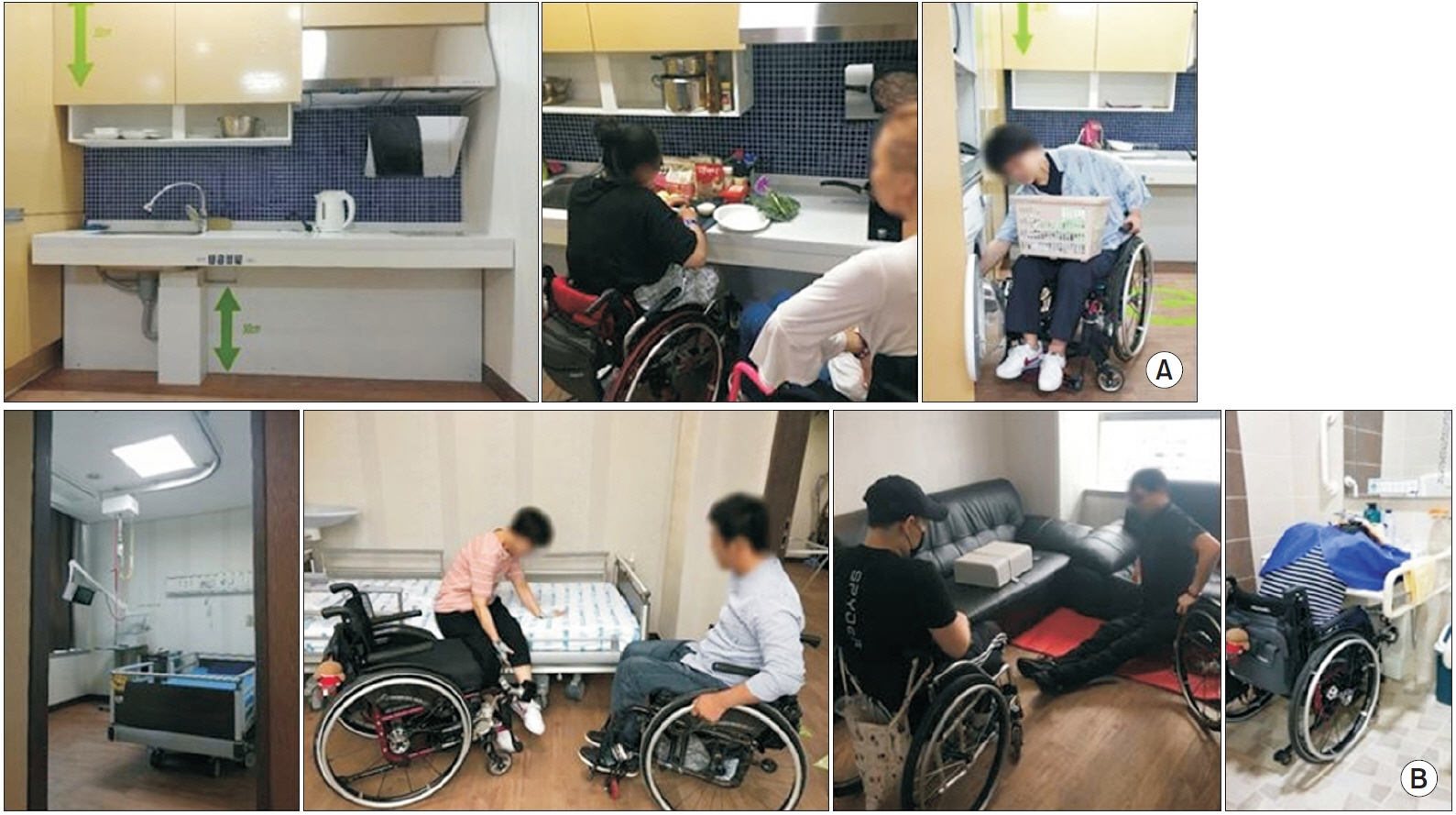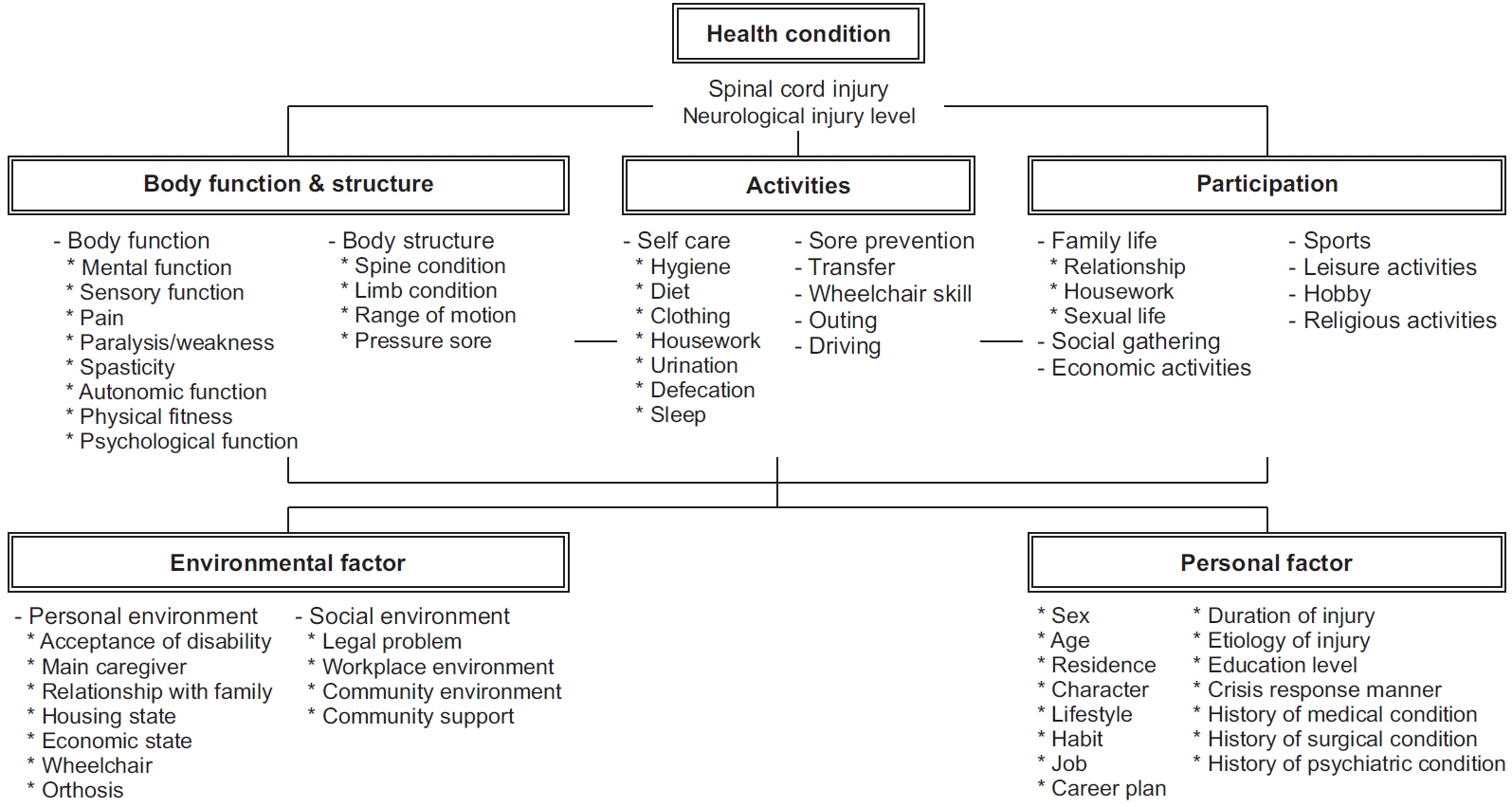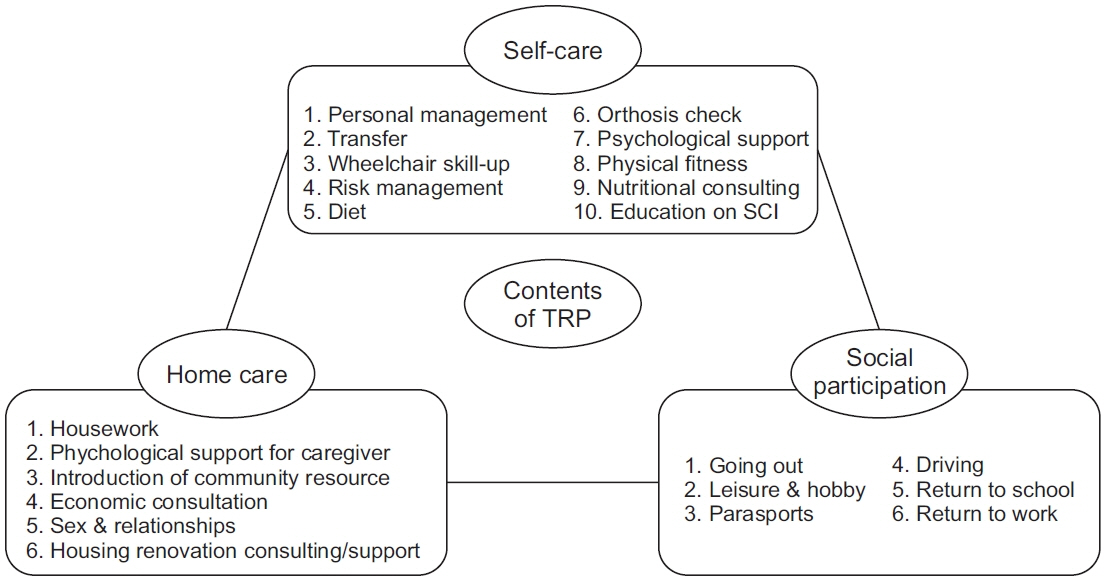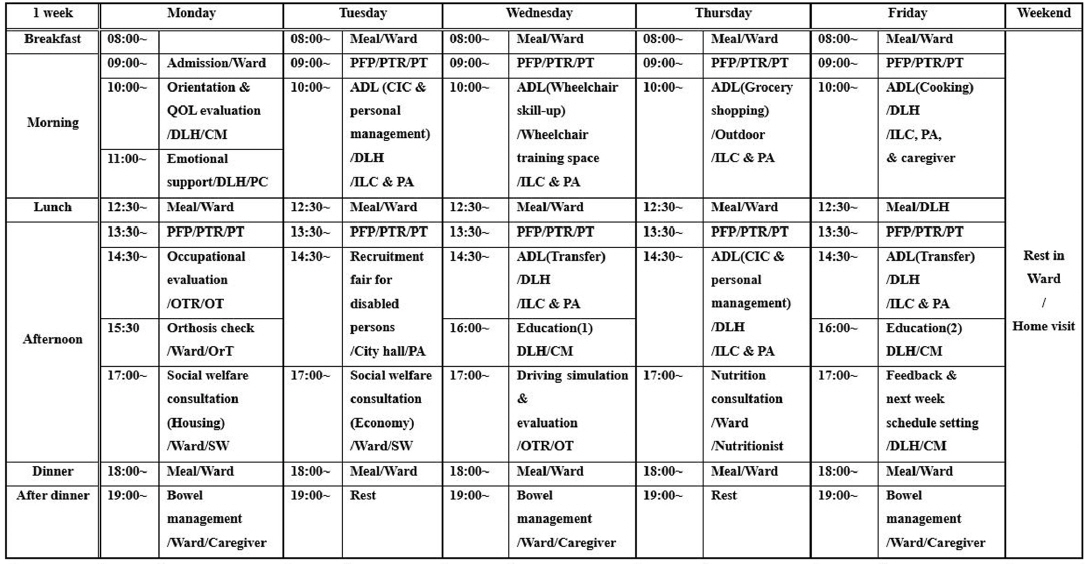Ann Rehabil Med.
2021 Oct;45(5):379-392. 10.5535/arm.21119.
Development and Evaluation of the Korean Version of Hospital-Based Transitional Rehabilitation Program Using Daily Living Home for Spinal Cord Injury
- Affiliations
-
- 1Department of Rehabilitation Medicine, Chungnam National University College of Medicine, Daejeon, Korea
- KMID: 2521910
- DOI: http://doi.org/10.5535/arm.21119
Abstract
Objective
To develop and evaluate the Korean version of a hospital-based transitional rehabilitation program (TRP), using daily living home for spinal cord injury (SCI) patients.
Methods
In this study, we developed the Korean version of a hospital-based TRP through domestic and overseas surveys and focus group meetings. By applying this to chronic SCI patients, we observed the functional and quality of life (QOL) changes and evaluated the degree of achievement of the core goals set for each patient during hospital-based TRP.
Results
Hospital-based TRP, for 21.8±3.9 days on average, was applied to four chronic SCI patients (two patients with long-term hospital stays and two homebound disabled individuals) with an average injury period of 736.8±185.4 days. The Korean version of the Spinal Cord Independence Measure (49.3±6.9 vs. 62.5±6.0; p<0.05) showed functional improvement at the end of TRP, when compared to that before the TRP. The Korean version of the World Health Organization’s QOL scale, abbreviated version (159.8±36.6 vs. 239.8±36.1; p<0.05), showed improvement in QOL. Goal attainment scaling showed a significant degree of achievement for the core goals through TRP (33.6±4.4 vs. 70.0±2.8; p<0.05). These results confirmed that the effect was maintained 1 month after the end of TRP. Additionally, two patients were successfully discharged after TRP completion, and the other two could start social activities.
Conclusion
The Korean version of the hospital-based TRP, applied to chronic SCI patients, showed the potential to improve the patients’ functioning and QOL and appeared to be effective in successful discharge and social participation.
Figure
Reference
-
1. Ministry of Health and Welfar. 2017 Survey on disabled persons [Internet]. Sejong, Korea: Ministry of Health and Welfare;2018. [cited 2021 Oct 4]. Available from: http://www.mohw.go.kr/react/jb/sjb030301vw.jsp?PAR_MENU_ID=03&MENU_ID=032901&CONT_SEQ=345972.2. Hoffman JM, Bombardier CH, Graves DE, Kalpakjian CZ, Krause JS. A longitudinal study of depression from 1 to 5 years after spinal cord injury. Arch Phys Med Rehabil. 2011; 92:411–8.
Article3. Derakhshanrad N, Vosoughi F, Yekaninejad MS, Moshayedi P, Saberi H. Functional impact of multidisciplinary outpatient program on patients with chronic complete spinal cord injury. Spinal Cord. 2015; 53:860–5.
Article4. Korea Spinal Cord Injury Association. 2018 needs survey report of disabled person with spinal cord injury [Internet]. Seoul, Korea: Korea Spinal Cord Injury Association;2018. [cited 2021 Oct 4]. Available from: http://www.kscia.org/board/view/menu03_05/21450.5. NZ Spinal Cord Injury Registry. NZSCIR Annual Report 2018 [Internet]. Christchurch, New Zealand: New Zealand Spinal Trust;2020. [cited 2021 Oct 4]. Available from: https://www.nzspinaltrust.org.nz/documents/31/NZSCIR-Annual-Technical-Report-2018.-FINAL..pdf.6. National Spinal Cord Injury Statistical Center. 2020 annual statistical report for the spinal cord injury model systems [Internet]. Birmingham, AL: University of Alabama;2020. [cited 2021 Oct 4]. Available from: https://www.nscisc.uab.edu.7. Royal National Orthopaedic Hospital NHS Trust. A patient’s guide to the London Spinal Cord Injury Centre [Internet]. Middlesex, UK: Royal National Orthopaedic Hospital NHS Trust;2009. [cited 2021 Oct 4]. Available from: https://www.rnoh.nhs.uk/application/ iles/2715/7234/9205/pg_lscic_booklet_201009_v3_final.pdf.8. Swiss Paraplegic Centre [Internet]. Nottwil, Switzerland: Swiss Paraplegic Centre;c2021. [cited 2021 Oct 4]. Available from: https://www.paraplegie.ch/spz/en/.9. Chen Y, DeVivo MJ, Richards JS, SanAgustin TB. Spinal cord injury model systems: review of program and national database from 1970 to 2015. Arch Phys Med Rehabil. 2016; 97:1797–804.
Article10. Queensland Spinal Cord Injuries Service. Model of care: Princess Alexandra Hospital [Internet]. Queensland, Australia: Queensland Spinal Cord Injuries Service;2018. [cited 2021 Oct 4]. Available from: https://www.health.qld.gov.au/__data/assets/pdf_file/0025/424735/qscis-moc-2018.pdf.11. van den Heuvel M, Jansz L, Xiong X, Singhal B. People with spinal cord injury in New Zealand. Am J Phys Med Rehabil. 2017; 96(2 Suppl 1):S96–8.
Article12. Ho SH, Yu SY, Kim YS, Bang MS, Lee BS, Kim DA, et al. The effects and development of a hospital based community reintegration support program for patients with spinal cord injury. J Rehabil Welf Eng Assist Technol. 2015; 9:89–103.13. Korean Academy of Rehabilitation Medicine. Daily life intensive training program, Labor Welfare Corporation Incheon Hospital. Proceedings of 2019 KARM Spring Conference on Industrial Accident Workshop;. 2019; Apr. 19-20. Cheongju, Korea.14. Aleris Rehab Station [Internet]. Stockholm, Sweden: Aleris Rehab Station;c2021. [cited 2021 Oct 4]. Available from: https://www.aleris.se/har-finns-vi/stockholm/rehab-station/om-oss/english/.15. Kanagawa Rehabilitation Hospital [Internet]. Kanagawa, Japan: Kanagawa Rehabilitation Hospital;c2021. [cited 2021 Oct 4]. Available from: https://www.kanariha-hp.kanagawa-rehab.or.jp/.16. Consortium for Spinal Cord Medicine. Outcomes following traumatic spinal cord injury: clinical practice guidelines for health-care professionals. J Spinal Cord Med. 2000; 23:289–316.17. Park JG. Development of Korean transitional rehabilitation system (TRS) model for rehabilitation to the society of persons with spinal cord injuries [dissertation]. Cheonan, Korea: Korea Nazarene University;2014.18. Choi HY, Jung DS, Kim JI. Focus group interview study on the impact of participation in back-to-community program on daily return for disabled with spinal cord injury. Korean J Phys Mult Health Disabil. 2017; 60:1–21.19. Korea Spinal Cord Injury Association. Daily living home program [Internet]. Seoul, Korea: Korea Spinal Cord Injury Association;2020. [cited 2021 Oct 4]. Available from: http://www.kscia.org/board/view/menu03_10/24467.20. Kendall MB, Ungerer G, Dorsett P. Bridging the gap: transitional rehabilitation services for people with spinal cord injury. Disabil Rehabil. 2003; 25:1008–15.
Article21. Spiess MR, Muller RM, Rupp R; EM-SCI Study Group, van Hedel HJ. Conversion in ASIA impairment scale during the first year after traumatic spinal cord injury. J Neurotrauma. 2009; 26:2027–36.
Article22. Steeves JD, Kramer JK, Fawcett JW, Cragg J, Lammertse DP, Blight AR, et al. Extent of spontaneous motor recovery after traumatic cervical sensorimotor complete spinal cord injury. Spinal Cord. 2011; 49:257–65.
Article23. Ditunno JF Jr, Stover SL, Freed MM, Ahn JH. Motor recovery of the upper extremities in traumatic quadriplegia: a multicenter study. Arch Phys Med Rehabil. 1992; 73:431–6.24. Ministry of Health and Welfare. Rehabilitation medical institution pilot project [Internet]. Sejong, Korea: Ministry of Health and Welfare;c2021. [cited 2021 Oct 4]. Available from: http://www.mohw.go.kr/re-act/policy/index.jsp?PAR_MENU_ID=06&MENU_ ID=06290301&PAGE=1&topTitle=.25. Wallace MA, Kendall MB. Transitional rehabilitation goals for people with spinal cord injury: looking beyond the hospital walls. Disabil Rehabil. 2014; 36:642–50.
Article26. Kendall MB, Wallace MA. Measuring goal attainment within a community-based multidisciplinary rehabilitation setting for people with spinal cord injury. Edorium J Disabil Rehabil. 2016; 2:43–52.
Article
- Full Text Links
- Actions
-
Cited
- CITED
-
- Close
- Share
- Similar articles
-
- The Study of the Development of Efficacy Expectation Promoting Program and it's Effect for Cervical Spinal Cord Injury Patients
- The Relationship Between Activity Daily Living and Powerlessness of Spinal Cord Injury Patient's
- Relationship of Activity of Daily Living and Self-Care Agency in Patients with Spinal Cord Injuries
- Changes of Functional Outcomes According to the Degree of Completeness of Spinal Cord Injury
- Factors Influencing Activities of Daily Living in the Patients with Spinal Cord Injury






